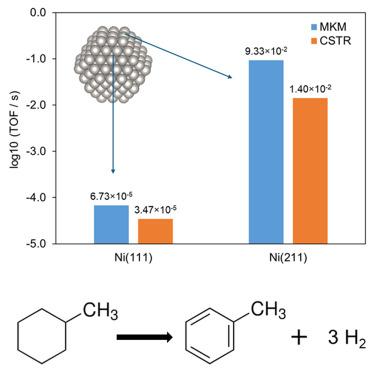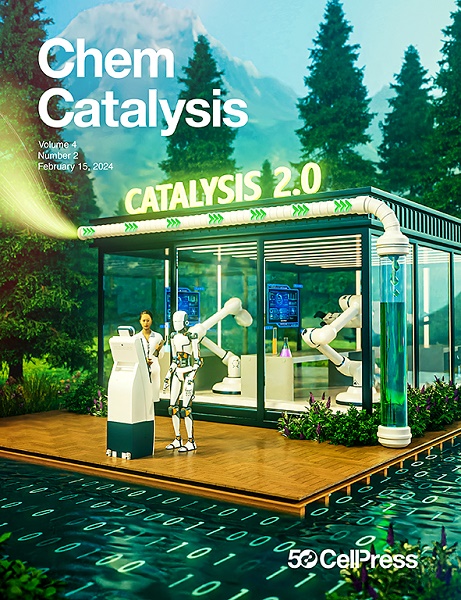密度泛函理论预测Ni催化剂表面结构对甲基环己烷脱氢反应的影响
IF 11.6
Q1 CHEMISTRY, PHYSICAL
引用次数: 0
摘要
甲基环己烷(MCH)脱氢制甲苯是液态有机氢载体(LOHC)体系的难点。本研究采用基于dft的微动力学模型研究了Ni(111)和Ni(211)表面的MCH脱氢反应。在低转化率下,甲基环己烯是主要产物,甲苯仅在Ni(211)表面产生(选择性约50%)。在更高的转化率下,在两个表面上观察到接近100%的甲苯选择性,突出了甲基环己烯再吸附和随后的脱氢的重要性。Ni(211)的反应速率比Ni(111)高约3个数量级,但其与甲苯和焦炭前体(C和CH)的结合更强,导致位点阻塞和潜在的焦炭形成。焦炭前体在Ni(111)上热力学不稳定。这些见解为优化LOHC应用的Ni基催化剂提供了双重策略:选择性地毒害不协调的边缘位点以减轻失活,并通过掺杂或合金化提高紧密堆积的Ni(111)活性。本文章由计算机程序翻译,如有差异,请以英文原文为准。

Surface structure effects on the methylcyclohexane dehydrogenation over Ni catalysts predicted by density functional theory
Dehydrogenation of methylcyclohexane (MCH) to toluene poses challenges in liquid organic hydrogen carrier (LOHC) systems. This study employs DFT-based microkinetic modeling to investigate the MCH dehydrogenation on Ni(111) and Ni(211) surfaces. At low conversion, methylcyclohexene is the primary product, with toluene only being produced on the Ni(211) surface (∼50% selectivity). At higher conversion, close to 100% selectivity to toluene is observed over both surfaces, highlighting the importance of methylcyclohexene re-adsorption and subsequent dehydrogenation. Ni(211) exhibits a rate approximately three orders of magnitude higher than Ni(111) but also suffers from stronger binding of toluene and coke precursors (C and CH), leading to site blocking and potential coke formation. Coke precursors are thermodynamically unstable on Ni(111). These insights suggest a dual strategy for optimizing Ni-based catalysts for LOHC applications: selectively poisoning undercoordinated edge sites to mitigate deactivation and enhancing the close-packed Ni(111) activity through doping or alloying.
求助全文
通过发布文献求助,成功后即可免费获取论文全文。
去求助
来源期刊
CiteScore
10.50
自引率
6.40%
发文量
0
期刊介绍:
Chem Catalysis is a monthly journal that publishes innovative research on fundamental and applied catalysis, providing a platform for researchers across chemistry, chemical engineering, and related fields. It serves as a premier resource for scientists and engineers in academia and industry, covering heterogeneous, homogeneous, and biocatalysis. Emphasizing transformative methods and technologies, the journal aims to advance understanding, introduce novel catalysts, and connect fundamental insights to real-world applications for societal benefit.

 求助内容:
求助内容: 应助结果提醒方式:
应助结果提醒方式:


